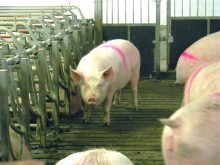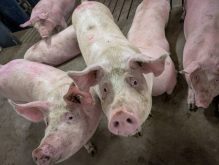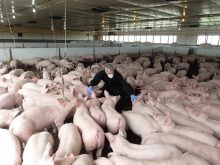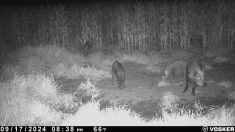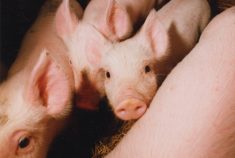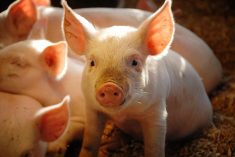Reuters / Europe’s pregnant pigs will be happier next year but pork eaters will pay more and some breeders will go out of business as new porcine welfare rules compound the spiralling cost of the cereals for animal feed.
Sow stalls, the metal cages used to hem in pregnant pigs and make them easier to control, are to be banned from Jan. 1 across the 27-nation European Union, 11 years after the ban was first voted in by the bloc’s lawmakers.
While animal rights groups welcome the move, the cost of applying the ban is expected to force more farmers out of the sector, leading to lower output and higher prices for Europe’s wurst, chorizo and prosciutto.
Read Also

Pig transport stress costs pork sector
Popular livestock trailer designs also increase pig stress during transportation, hitting at meat quality, animal welfare and farm profit, Agriculture and Agri-Food Canada researcher says
“We are at the beginning of a shock wave,” Jean-Michel Serres, chairman of the French pig producers’ group FNP, said.
“It will have a significant impact on pork prices and pose problems for the industry,” he warned of a ban which in France he estimates will add 650 euros per pig to costs in a sector where many farmers are already at break-even or loss making.
Significant impact
EU farmers produced a record 22.7 million tonnes of pork in 2010, or more than 20 per cent of the world’s total production. That was twice the volume of the United States, but still far behind China’s output of 51 million, EU and U.S. data showed.
A new EU ban on layers’ cages already led to a doubling of egg prices in some countries earlier this year.
The rise in pork prices is unlikely to be so steep because the sector has more capacity to absorb cost increases through its processing chain, and consumers can easily turn to other cheap meats such as poultry.
But industry players contacted by Reuters said they would seek to secure at least some of the 10 per cent rise in prices they estimate would preserve their existing shaky margins.
Ear biting
Farmers use sow stalls in intensive pig farming to help with often fraught feeding times and deal with aggression such as ear biting. But animal welfare campaigners say sows suffer psychologically from being separated from other animals, and are hit by ailments such as lameness.
At a meeting of farm and industry officials last week, the European Commission forecast between three and four per cent of pig breeders would halt production next year, two sources at the talks said.
EU pig production would in turn fall five per cent over the next three years because of the sow stall ban — one per cent this year, three per cent in 2013 and one per cent in 2014, they said.
The commission declined to comment on estimates and data given at the meeting. Some farmers have already been forced out of the sector because of this year’s surge in the price of grains, which account for 30 per cent of total costs, after severe droughts in the United States and the Black Sea regions.
The impact of the ban will differ widely by country. Britain, Sweden and Luxembourg have already banned the stalls.
Britain, which put its ban in place in 1999, saw a 40 per cent fall in its herd over the last decade as its farmers were unable to compete with countries which did not use such stalls. Production this year is finally recovering.
Output down
But output is seen hit hard in Germany, the EU’s largest pig meat producer with a market share of 25 per cent in 2010.
“It is still unclear how many will give in but a double-digit percentage fall in German production cannot be ruled out,” Michael Lohse of the German farmers’ association DBV said.
In France, FNP expects one in 10 breeders to quit the sector.
In the run-up to the ban, EU breeders have been hurrying to adapt their farms but the commission expects only 17 out of the 27 member states to fully comply by year-end, leaving more than a third of the bloc behind schedule despite the 11-year notice.
Farmers in Germany and Spain are nearly ready but in France, they are well off track, farmers’ groups and officials said, even if there has been a huge boost in recent months. Only 50 per cent of French farmers complied by the summer, FNP said.
Some breeders will not even try to comply.
The additional costs — pegged at around 650 euros ($840) per sow in France — come at a difficult time for many of them, already struggling with higher feed costs.
Pig’s toilets next?
While the impact will be felt across the full range of Europe’s food products, quantifying the exact effect is hard.
The full extent of the sow stall ban will only be felt a few months after implemented when all the piglets born before the move have been slaughtered.
“We are bound to raise our prices… Today we already need a 10 per cent increase just to keep our margins, and it will be worse next year, but we need to convince retailers,” said Robert Volut, head of EU meat-processing industry body CLITRAVI.
Further down the road new animal welfare regulations will come up, with measures such as those tested in a Dutch farm run by the University of Wageningen.
Fattening pigs are kept in an open space with dedicated areas — one for playing, one for eating, one for sleeping and the fourth one which serves as a toilet.
Such measures will inevitably add further costs to the production process — but even those involved in such projects acknowledged there is a limit to how much of a premium consumers are prepared to pay for animal welfare.
“Animal welfare costs,” said Daniel Somers, manager of the Dutch farm being used for the tests.
“All consumers say they want improvement of animal welfare, when they go to the supermarket they buy the cheapest meat.”






